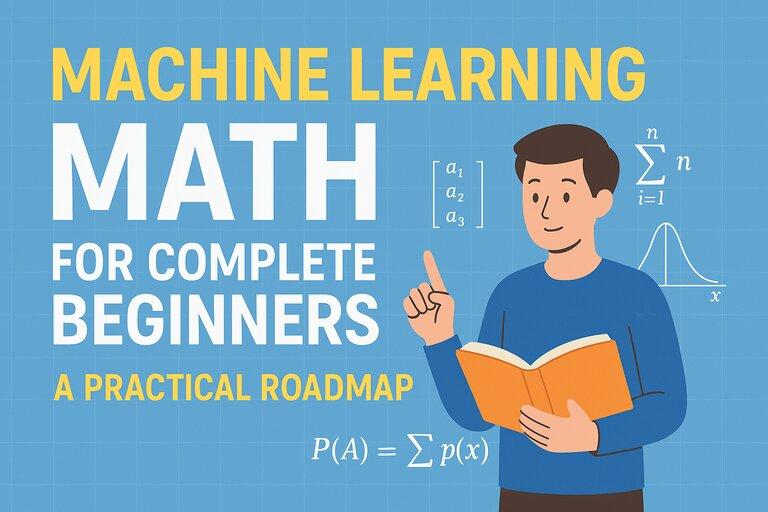Many aspiring machine learning professionals feel intimidated by the mathematical requirements of the field. The prospect of mastering complex mathematical concepts can seem overwhelming, especially for those without a strong mathematical background. However, the reality is far less daunting than you might think. While mathematics is indeed essential for machine learning, the level of expertise required varies significantly depending on your career goals and the type of roles you're pursuing. This guide will provide you with a clear roadmap, effective resources, and proven study strategies to master the mathematics you need for a successful career in machine learning.
Do You Really Need Mathematics for Machine Learning?
The short answer is yes, but the extent and level of mathematical knowledge you need depends heavily on the type of roles you're targeting and the companies you want to work for.
Research-Focused Positions
If you're aiming for positions such as research scientist, research engineer, or applied research engineer, you'll need high-level mathematical knowledge. These roles are inherently research-based and demand a deep understanding of mathematical concepts, typically at the master's or PhD level.
Companies like DeepMind, Meta Research, Google AI, and Microsoft AI are fundamentally research labs. Working at these organizations requires quite advanced mathematical expertise because they're pushing the boundaries of what's possible in artificial intelligence. Most people in these positions hold at least a bachelor's degree in mathematics, statistics, physics, or related disciplines, with many having master's degrees or PhDs.
According to data from the 2011 Kaggle data science survey, which collected information from professionals working in data science and machine learning, the research scientist position is heavily favored toward people with PhDs. The data also shows that in general, the higher level of education you have, the more money you will typically earn within the field. This correlation likely extends to mathematical skills as well.
While this may sound disheartening to some, it's important to acknowledge this reality. If you want to work at top research labs, you typically need a high level of education, whether that's a master's degree or PhD.
Industry-Focused Positions
However, it's crucial to understand that this is just a trend, not an absolute requirement. Many people from non-mathematical backgrounds who may not have exceptionally strong math skills do remarkably well in the field, particularly in industry roles.
If you're working in industry writing production code, you don't necessarily need top-tier mathematical knowledge. Most of your work will revolve around translating business problems into tangible machine learning and statistical models. For this, you don't need PhD-level mathematical expertise. In some cases, you don't even need to apply sophisticated mathematical machine learning models, as basic rule-based decision-making systems work perfectly fine.
This is where you can provide tremendous value as an employee. If you understand the business and know how to effectively solve problems, you don't necessarily need exceptionally advanced mathematical knowledge. You just need strong critical thinking skills and deep domain expertise.
For the majority of industry-based machine learning roles, high school level mathematics is normally sufficient. You may need to learn a few more advanced topics typically taught within the first few years of an undergraduate math, statistics, or physics degree, but you don't have to master everything in those degrees. Just focus on a few key areas to sharpen your skills and understand the fundamental concepts behind certain algorithms.
The mathematics required for these positions, where the majority of people work, is not super high-level and is very achievable by most people. In a nutshell, while you do need mathematics to work in machine learning, for most roles, you don't need to be a mathematical wizard. High school level mathematics should cover most of your bases.
That said, having really good math skills is certainly a positive in your career. The more mathematics you know, the better, but it's certainly not a deal-breaker in progressing your career.
The Three Essential Mathematical Areas
There are three core mathematical areas you should learn for machine learning: statistics, calculus, and linear algebra. Let's explore each of these in detail.
Statistics: The Foundation of Machine Learning
In terms of practical application, statistics is probably the area you'll use most if you work in machine learning. Most of current machine learning actually originated from statistical learning theory, so the crossover is very high.
Descriptive Statistics
Start with descriptive statistics, which covers fundamental concepts like mean, median, standard deviation, quantiles, and correlation. You should also become familiar with visualization plots including histograms, bar charts, line graphs, pie charts, and violin plots. Anything that describes data through summary statistics falls under this topic.
Probability Distributions
Understanding various probability distributions is crucial. Focus on learning:
- Binomial distribution
- Poisson distribution
- Normal distribution
- Gamma distribution
These distributions are essential because they're needed when making assumptions about your data and understanding exactly what model to fit. Sometimes it may be a basic linear regression, other times a gamma regression or Poisson regression. Understanding how these distributions work allows you to choose the correct model for your current task.
Probability Theory
Probability theory is probably one of the most important concepts to master. Since machine learning comes from statistical learning theory, which itself is based on probability theory, you should learn concepts like maximum likelihood estimation and Bayesian statistics. These are fundamental concepts in the entire statistics space, so you should grasp them to a good level.
Hypothesis Testing and Confidence Intervals
In your machine learning career, you'll encounter a lot of testing. It's crucial that you understand hypothesis testing and confidence intervals. Most companies run AB tests where they have a test group and a control group, and the way you decide whether your experiment or model is significant is through hypothesis testing. This is an invaluable skill for anyone wanting to work in the data field in tech.
The tests you should learn include:
- Z test
- T test
- Chi-square test
- F test
While there are many different types of tests, understanding the general process is sufficient for most applications.
Modeling and Inference
Finally, learn modeling and inference. Focus on fundamental regression algorithms like linear regression, generalized linear models, and polynomial regression. These come from fundamental statistics and predate machine learning as a concept, but they form the backbone of many machine learning applications.
Calculus: Understanding How Algorithms Learn
After mastering statistics, move on to calculus. Calculus describes exactly how machine learning algorithms actually learn. Their learning is accomplished through optimization, which is carried out through calculus processes. It's crucial that you grasp at least the key concepts in this area.
Essential Calculus Topics
The areas you want to learn include:
- What is a derivative and what does it do
- Derivatives of common functions like sine, cosine, and the exponential
- Turning points, especially maxima and minima, and how they relate to gradient descent
- The chain rule and product rule, which are essential for understanding backpropagation in neural networks
- Partial derivatives and multivariable calculus
- The difference between convex and non-convex functions
You should also cover integration, including what integration is, the integral of common functions, and how to integrate by parts and by substitution. In general, everything you learn about differentiation, you should also learn for integration.
Linear Algebra: The Language of Machine Learning
After learning statistics and calculus, it's time to tackle linear algebra. Linear algebra is the field of mathematics that deals with matrices, vectors, and the linear transformations between them. Matrices are used everywhere in machine learning. For example, in the TensorFlow library, the word "tensor" is actually an n-dimensional matrix. Even one of the most popular machine learning libraries essentially has "matrix" in its name.
Vectors
Start by learning about vectors. Understand what vectors are, their magnitude and orientation, and how vectors are transformed. The main goal is to understand how to actually work with vectors. Vectors also intersect with calculus to form vector calculus, demonstrating how all these mathematical fields interconnect with each other.
Matrices
After vectors, learn about matrices. Matrices are basically n-dimensional vectors, so they're an extension of what you learned in the previous section. An example of matrix usage is the weights and biases in neural networks. While biases are typically vectors because they're one column, weights are usually represented as rows and columns, making them matrices.
Matrix Operations and Transformations
Learn basic operations and transformations including:
- Trace
- Determinant
- Transpose
Focus particularly on eigenvalues and eigenvectors. While this is a specialized topic within linear algebra, it's highly applicable to machine learning because it's the backbone of Principal Component Analysis (PCA), which is used frequently for feature selection in models. Learning eigenvalues and eigenvectors, though challenging, is crucial because you'll use them quite often in the field.
Systems of Equations
Finally, learn about systems of equations. These are used extensively for optimization problems. While they may not appear constantly depending on the nature of your work as a machine learning engineer or data scientist, they're important to understand. Having this knowledge allows you to immediately recognize when a problem can be solved using systems of linear equations.
Recommended Resources for Learning
There are numerous resources available, and the best choice depends on your learning style.
Textbooks
If you prefer learning from textbooks, these two are essential:
Practical Statistics for Data Scientists
This book is by far the best textbook if you want to learn statistics for data science or machine learning because it's specifically made for those fields. You literally can't go wrong with it, and it's the only textbook you need to really learn statistics.
Mathematics for Machine Learning
This textbook covers all your bases for linear algebra, calculus, and even statistics. These two textbooks together provide everything you need. Don't overcomplicate things by searching for additional resources.
Online Courses
If you prefer learning through online courses, the Mathematics for Machine Learning and Data Science Specialization comes highly recommended. This course is by DeepLearning.AI, created by Andrew Ng, who also made the best machine learning course available, the Machine Learning Specialization. If this mathematics course is anything like that one, it's probably the best option you can take.
How to Study Effectively
The amount of mathematical knowledge required may seem overwhelming, but the key is to break it down step by step.
Getting Started
Start by picking just one of the three areas: linear algebra, statistics, or calculus. Look at everything discussed earlier that you need to know for that topic, then choose one resource from the recommendations. That's the initial work done.
Don't overcomplicate things by trying to find the "best" resource because such a thing doesn't exist. Pick one of the three topics, find the list of concepts you need to know, and choose one resource. Don't overthink it. Just stick with that approach, and you've completed the initial planning phase.
Active Learning Strategies
Now it's time to work through the resource, but don't just blindly read or watch videos. Actively take notes and document your learning. One powerful technique is writing blog posts about what you're learning. This employs the Feynman Technique, where teaching others helps develop your own understanding. This is an incredibly powerful learning tool.
If writing blog posts seems too ambitious, simply ensure you're actively taking notes in your own words, either digitally or physically. This way, you can reference them later, and you'll understand them better because they're written in a way that makes sense to you personally.
The Three Pillars of Effective Learning
The learning process is straightforward, and studies have shown how you can learn most effectively. The general approach involves three key principles:
- Do a little bit every day
- Review old concepts frequently, which is known as spaced repetition
- Document your learning
With these three steps, you will learn mathematics effectively. Don't overcomplicate the process. Just follow this approach, and you'll make rapid progress.
Conclusion
Learning mathematics for machine learning doesn't have to be an insurmountable challenge. While the field does require mathematical knowledge, the level you need depends entirely on your career goals. For research positions at top labs, advanced mathematical expertise is essential. However, for the majority of industry roles, high school level mathematics supplemented with a few undergraduate topics is sufficient.
Focus on the three core areas: statistics, calculus, and linear algebra. Choose quality resources like "Practical Statistics for Data Scientists" and "Mathematics for Machine Learning," or opt for the Mathematics for Machine Learning and Data Science Specialization online course. Most importantly, approach your learning systematically by choosing one topic at a time, actively documenting your progress, and practicing spaced repetition.
Remember, the goal isn't to become a mathematical wizard overnight. It's to build a solid foundation that enables you to understand and apply machine learning concepts effectively. With consistent effort, the right resources, and effective study strategies, you can master the mathematics needed for a successful career in machine learning.







